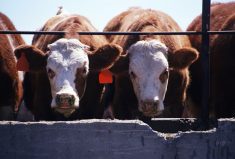Compared to last week, western Canadian yearling prices were steady to $2 higher on average while calf markets were up $2-$4.
There was an increase in activity over the past week, although many auction barns remain in holiday mode. Major feedlot operators in southern Alberta were extremely aggressive on yearlings fresh off grass and this set the market structure. The stronger tone rippled across Western Canada into all weight categories. Finishing feedlots that had unfilled yearling orders were accepting mid-weight and lighter-weight steers. Canadian prices were lagging main U.S. markets but this disparity appears to have evaporated over the past week. Backgrounders were filling in demand voids as there were once again many singles and small packages under five head. Alberta packers were buying fed cattle at $177 f.o.b. the feedlot. Margins remain in red ink for nearby pen closeouts but look more promising for the fourth quarter of 2022 and first quarter of 2023. Renewed optimism has spurred on demand for feeder cattle.
Read Also

U.S. grains: Wheat futures slide on rising world production estimates
U.S. wheat futures fell more than one per cent on Wednesday to their lowest since late October on reminders of…
In central and southern Alberta, steers fresh off grass weighing 1,000-1,050 lbs. were trading in the range of $205 to as high as $210; steers weighing 950-1,000 lbs. were quoted from $208-$212 and steers averaging 900-950 lbs. were valued between $212 and as high as $218. It’s a sleeper market that’s ambitiously crawling higher. Buyers want to accumulate volume without running up the market and it’s a difficult task. Ranchers are being approached from repetitive customers in an effort to secure ownership this fall.
A small group of Angus-blended steers weighing 650 lbs. with full health data on forage diet were valued at $218 and similar-quality steers weighing 550 lbs. were quoted at $220. In east-central Saskatchewan, mixed steers averaging 650 lbs. were quoted at $244 and their younger brothers averaging 550 lbs. were $252. It’s that time of year when the market is quite diverse due to small packages on offer.
In central Alberta, there were quite a few small packages or pee-wee or featherlight calves. For example, mixed steers weighing 340 lbs. were quoted at $227 and red mixed heifers weighing 470 lbs. were reported at $192.
Last week’s world agricultural supply and demand estimates (WASDE) from the U.S. Department of Agriculture had fourth-quarter beef production at 6.745 billion lbs., down nearly 350 million lbs. from the final quarter of 2021. Farmers in Western Canada expect above-average yields for barley. The feeder market is factoring in a tight supply of fed cattle and abundant feed grains for the October-through-December timeframe of 2022.
— Jerry Klassen is president and founder of Resilient Capital, specializing in proprietary commodity futures trading and market analysis. Jerry consults with feedlots on risk management and writes a weekly cattle market commentary. He can be reached at 204-504-8339 or via his website at ResilCapital.com.















